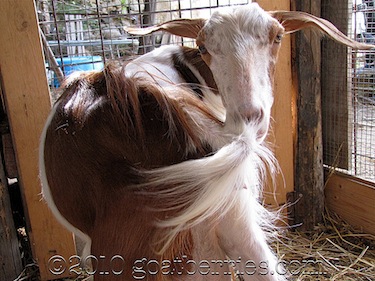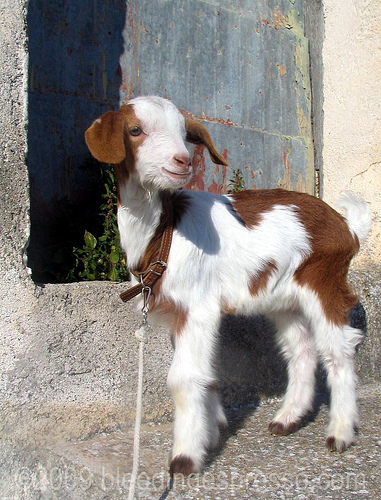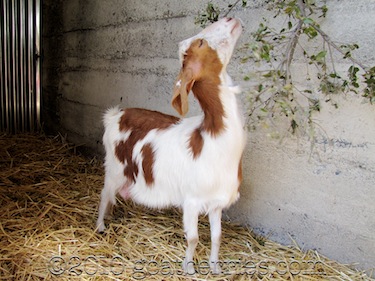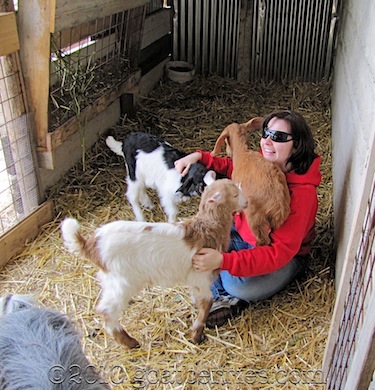Archive for the ‘Goat Basics’ Category
Goat Veterinarians, Herbal Wormers, and Anti-Parasitic Washes
A question I get a lot is whether there are veterinarians in this rural part of southern Italy; there definitely are, and clients probably use their services just as much if not more for goats, sheep, and horses as for cats and dogs. In that sense, we’re probably luckier than many in, say, America, who may have a more difficult time finding an experienced goat vet.
Indeed, our veterinarian regularly makes house calls, even for dogs and cats. We prefer that our animals live rather naturally with as many herbal/holistic remedies and as few doctor’s visits as possible, but our goats suddenly developed an issue with pidocchi (lice) and Pinta had a bit of a cough that I thought may have been related to lungworms, so the doc came the other day and gave them each an Ivomec shot, which should take care of all their internal and external parasite issues.
Indeed the girls seemed brighter-eyed and more playful just an hour or so after the meds, so hopefully that means they were working. Or, you know, they got high. Hey, happy goats are a good thing!
Anyway, I really would much prefer to try herbal wormers, but I haven’t found any in Italy; if you happen to know of any, please let me know.
Also, the vet recommended a spray-on anti-parasitic treatment for cleaning the pen, but it sounds pretty chemically powerful. I’m wondering if any of you have suggestions on more natural methods so we can keep our goaties from doing a lot of this in the future?
What types of wormers and anti-parasitics do you use?
What’s New on Pasqualina’s Plate?
Last summer was our first summer with goats, and my first experience with goats, so I wasn’t very adventurous in what to feed them. They were only between five to seven months old at that point, so I was nervous I’d give them something that would upset their digestive tracts. We stuck to feed, fresh grasses, and hay.
Now that lots of fruits and veggies are coming into season, though, and we have a big strong Mamma goat, I feel like it’s time to test Pasqualina’s palate. Besides, there are also a lot more peels and shavings and even the errant strawberry that’s going off, so it’s a great way to recycle the food, so to speak (if the goats don’t eat it, it goes to the chickens).
So after making sure the food is not poisonous for goats, I’ve been trying new samples with Pasqualina, always a little at a time as you never want to give goats large amounts of any new food as it can, indeed, upset their digestive systems.
You’ve already seen some results of our new experimenting with pea pods and cantaloupe; Pinta hasn’t shown interest in anything but the pea pods and prickly pear cactus so far, but we’ll keep an eye on that too.
One huge surprise for me has been the strawberry. Pasqualina won’t even take one! How can you not like this fresh from the garden?
It’s been a fun experience for me, so I’m now keeping track of what Pasqualina (and eventually Pinta) likes and doesn’t like to eat on a page called “Goat Eats,” which you can always find in the upper right corner of every page.
Please feel free to tell me what your goats like and don’t like in the comments!
Letting Your Kids Cry It Out
I know this topic is something that mothers of human babies deal with all the time, but did you know goat maaaas must deal with this as well?
Inevitably there are times when goats, especially kids, cry for their humans. They may be hungry, they may be thirsty, or they may just want some company. Goats are *very* social creatures and hate being left alone, which is why they say you should never have just one goat. Indeed, it’s the reason we added Margherita last year around this time, so Pasqualina wouldn’t have to be alone.
Before we found Margherita, Pasqualina would WAIL when we left her. And I don’t just mean quaint little bleats. She actually sounded like she was in pain — and quite frankly, she probably was, emotionally. Poverina! She was just a wee lass at the time, so it’s not surprising that she wanted us around.
But then along came a buddy, and she was fine ever since.
Now, though, since we’ve taken out the others, it’s just her and her daughter Pinta in the pen . . . and she again cries when we leave. Not all the time, not as dramatically, and not for nearly as long as she used to, but ask any mother (of humans or otherwise), and she’ll tell you just how heartbreaking it is to hear their kids cry.
And although I don’t know that I could let human kids cry it out (taking after my mother in this respect), with goats, you just have to walk away — assuming you can’t play in the goat pen all day.
Answering Goat Questions: Part II
Following up Answering Goat Questions: Part I, here is Part II:
6. “why do goats poop berries” – This has to do with the way their digestive system is set up (hint: nothing like ours) and what they eat, but you can read all about it at The Straight Dope.
7. “coffee discovered by goats” – Well, yes, kind of. Read all about it at The Legend of Coffee and the Dancing Goats.
8. “training goats” – Hah! Good luck with that. No, seriously, depends on the kind of training you want to do. Goats are highly intelligent, but they can also be stubborn. We’ve taught two of ours to walk on leashes. I don’t know about house-training, though…those little trap doors seem to open and drop a load of goat berries whenever they damn well please.
9. “who is pasqualina” – OK, I don’t know for sure that you were actually looking for *my* Pasqualina, but you can find lots of photos of her on Flickr, her kidding story on this site, and various posts about her at Bleeding Espresso.
P.S. She looks like this:
10. “michelle fabio” + paolo” – OK, pretty sure you were looking for us on this one. Congratulations! You are here.
That’s all until next time; thanks for finding us!
Answering Goat Questions: Part I
Those of you with websites know that far too much fun can be derived from looking through the search terms people used to find your site.
The searches for Goat Berries have been extra interesting to read as they let me know what fellow goat people want to know. I’ve noticed some questions I haven’t yet answered, so I’m going to answer some here (mostly about the kidding process) and then more in Part II, forthcoming:
1. “lover of goats in Italian” – Literally, it would be “l’amante delle capre,” but in Italian you’d more likely say someone is “appassionato (or appassionata if it’s a woman) delle capre.” It’s safe to say I’m one of those.
2. “should I separate goat when kidding” – Most things I read on the Internet and in books talk about kidding stalls to separate the mom from the rest of the herd when she’s about to give birth. In fact, we did separate out one of our moms because we thought she’d be more comfortable that way.
The other two of our dams, though, gave birth in the same pen with the other present (and one even had another kid present). Everything went fine, but I imagine this is something you get a feel for regarding specific goats and their preferences.
3. “goat how long after water sac birth” – When Pasqualina gave birth, her water broke, she had about two minutes of rest (if that), and then she started pushing. We had a kid within five minutes or so, with the whole birth taking not more than 15 minutes.
4. “goat kidding – fresh blood” – This is an interesting query. I actually expected more blood with the birth of the kids, but there really wasn’t any during the actual birth. Lots of goo, yes, but not blood.
The moms *did* however pass fresh blood the following day (usually in clots) and also for the following two weeks — *not* constant streams of blood by any means, just every once in a while. In sum, if you think you’re seeing too much blood, you probably are, so call a veterinarian. Better to err on the side of caution.
5. “what if the goat doesn’t deliver the placenta” – You could have yourself a problem here. A new goat mom should pass her placenta within 24 hours or so of giving birth, but if you weren’t watching the whole time, she may have eaten it. Or a dog may have eaten it, if it had access.
Our three goats all passed the placenta completely within two or three hours of giving birth (in all cases it started to come out almost immediately). If yours hasn’t done so after a whole day, you may have a “retained placenta” on your hands, and you should consult a veterinarian. Basically the vet is going to have to give her something to start contractions to get it out.
Stay tuned for more questions and answers in Part II!
Buon weekend!
Caprine Terminology: Common Goat Words
When I started reading up on goats, I quickly realized there are many terms other than “goat” and “kid” that are important to know.
I was reminded of this by Dianne of La Bella Lingua yesterday in the comments, so especially for those of you new to this goat thing, here are some common goat words you’re likely to come across:
- Kid: a goat from birth to six months of age
- Doeling: sexually immature female goat (kind of like a pre-teen)
- Buckling: sexually immature male goat
- Doe: sexually mature female goat
- Dam: a female goat who has kidded a.k.a. Mamma Goat
- Buck: sexually mature male goat (also sometimes called a “billy”)
- Wether: castrated male goat
- Yearling: one-year-old goat
You may also see the term “chevron,” which is, no not the energy company, but the technical term for goat meat.
Another interesting term I’ve come across is “freshen,” which is what happens when the doe gives birth and begins producing milk. Isn’t that quaint? Our does freshened up a storm a couple weeks ago! Hah!
In the coming days, I’ll write more about the basic facts of breeding/kidding, feeding, behavior, etc., but if you have any burning goat questions along the way, please do ask in the comments!





















